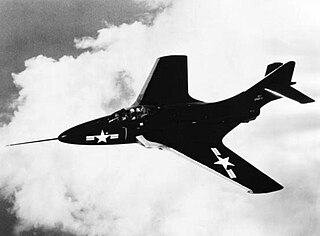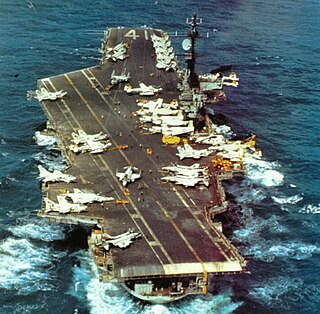
Strike Fighter Squadron 211 (VFA-211), nicknamed the "Fighting Checkmates", is an aviation unit of the United States Navy established in 1945. The squadron is based at Naval Air Station Oceana and is equipped with the F/A-18F Super Hornet.
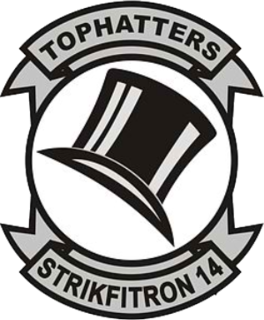
The Strike Fighter Squadron 14 (VFA-14) "Tophatters" are a United States Navy fighter attack squadron based at Naval Air Station Lemoore. They fly the F/A-18E Super Hornet, and are the Navy's oldest active squadron, having formed in 1919. Their callsign is Camelot, and their tail code is NG.
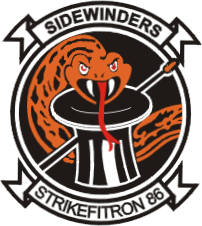
Strike Fighter Squadron 86 (VFA-86) is a strike fighter squadron of the United States Navy based at Naval Air Station Lemoore, California. The squadron is nicknamed Sidewinders, leading to the call sign Winder. The unit currently flies the F/A-18E Super Hornet and is assigned to Carrier Air Wing Seven, tail code AG.

Naval Air Station Oceana or NAS Oceana is a military airport located in Virginia Beach, Virginia, and is a United States Navy master jet base. It is also known as Apollo Soucek Field, named after Lieutenant Apollo Soucek, a Navy Test Pilot who set the global altitude record in 1930 by flying a Curtiss "Hawk" biplane to an altitude of 43,166 feet. NAS Oceana is the only Master Jet Base on the East Coast.

A carrier air wing is an operational naval aviation organization composed of several aircraft squadrons and detachments of various types of fixed-wing and rotary-wing aircraft. Organized, equipped and trained to conduct modern US Navy carrier air operations while embarked aboard aircraft carriers, the various squadrons in an air wing have different but complementary missions, and provide most of the striking power and electronic warfare capabilities of a carrier battle group (CVBG). While the CVBG term is still used by other nations, the CVBG in US parlance is now known as a carrier strike group (CSG).

Fighter Squadron 124 or VF-124Gunfighters was a fleet replacement squadron (FRS) of the United States Navy. Originally established on 16 August 1948 as VF-53 it was redesignated VF-124 at NAS Moffett Field on 11 April 1958 due to a need for an increased number of flight training squadrons, itself necessary because of introduction of swept wing fighters into Navy service. In 1961, the squadron relocated to NAS Miramar, California, which would become the U.S. Pacific Fleet's Master Jet Base for fighter aircraft.

VFA-22, Strike Fighter Squadron 22, also known as the "Fighting Redcocks", are a United States Navy F/A-18F Super Hornet fighter squadron stationed at Naval Air Station Lemoore, California. Their tail code is NA and their radio callsign alternates between "Beef" and "Beef Eater".

Strike Fighter Squadron 113 (VFA-113), also known as the "Stingers," is a United States Navy strike fighter squadron based at Naval Air Station Lemoore, California. They are an operational fleet F/A-18E Super Hornet squadron attached to Carrier Air Wing 17 (CVW-17) and based at NAS Lemoore, California. Their tailcode is NA and their radio callsign is Sting.

Strike Fighter Squadron 34 (VFA-34), also known as the "Blue Blasters", is a United States Navy F/A-18C Hornet strike fighter squadron stationed at Naval Air Station Oceana. They are a part of Carrier Air Wing 2 and are attached to the aircraft carrier USS Carl Vinson. Their tail code is NE and their radio call sign is "Joker".

Strike Fighter Squadron 81 (VFA-81), also known as the "Sunliners", is a United States Navy F/A-18E Super Hornet strike fighter squadron stationed at Naval Air Station Oceana. They are a part of Carrier Air Wing One, their radio callsign is Inferno, and their tail code is AB. Their mission is to conduct prompt and sustained combat operations from the sea. The squadron was originally designated VA-66 on 1 July 1955, was redesignated VF-81 the same day, redesignated VA-81 on 1 July 1959, and finally redesignated VFA-81 on 4 February 1988.

Strike Fighter Squadron 83 (VFA-83), also known as the "Rampagers", are a United States Navy F/A-18E Super Hornet fighter squadron stationed at Naval Air Station Oceana. They are a part of Carrier Air Wing 3, their tailcode is AC and their radio callsign is Ram.

John "Jack" Lawrence Finley was a United States Navy aviator and was selected as an astronaut.
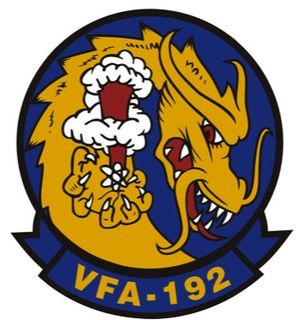
Strike Fighter Squadron 192 (VFA-192), also known as the "World Famous Golden Dragons", are a United States Navy F/A-18E Super Hornet fighter squadron stationed at NAS Lemoore.
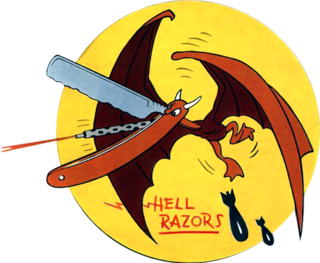
Attack Squadron 174 (VA-174) also known as the "Hellrazors" was a United States Navy attack squadron based at Naval Air Station Cecil Field, Florida, and were attached to Light Attack Wing One. It was commissioned from 1944 to 1988.

Strike Fighter Squadron 204 (VFA-204), also known as the "River Rattlers", is a U.S. Navy Reserve strike fighter squadron flying the F/A-18A+ Hornet. The squadron is based out of Naval Air Station Joint Reserve Base New Orleans and is part of the United States Navy Reserve's Tactical Support Wing. Their radio callsign is River and their tail code is AF.

VA-106 was an Attack Squadron of the U.S. Navy. Originally established as Bomber-Fighter Squadron Seventeen (VBF-17) on 2 January 1945, it was redesignated Fighter Squadron Six B (VF-6B) on 15 November 1946, redesignated VF-62 on 28 July 1948, redesignated Attack Squadron 106 (VA-106) on 1 July 1955, it was disestablished on 7 November 1969. It was the second US Navy squadron to be designated VA-106.
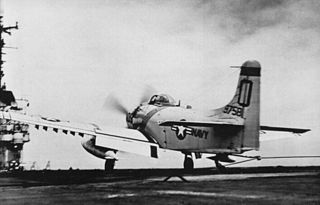
VA-16 was a short-lived Attack Squadron of the U.S. Navy, established at NAS Oceana on 1 June 1955. Its motto was Per Aspera Ad Metam. The squadron was disestablished on 1 March 1958.

Attack Squadron 54 (VA-54) was an attack squadron of the U.S. Navy. Originally established as Bomber Fighter Squadron VBF-153 on 26 March 1945, redesignated Fighter Squadron VF-61A (VF-16A) on 15 November 1946, redesignated VF-152 on 15 July 1948, and VF-54 on 15 February 1950. It was finally redesignated VA-54 on 15 June 1956. The squadron was disestablished on 1 April 1958. It was the second squadron to be designated VA-54, the first VA-54 was disestablished on 1 December 1949.

VA-34, nicknamed the Blue Blasters, was an Attack Squadron of the U.S. Navy. The squadron was established as Fighter Squadron VF-20 on 15 October 1943, redesignated as VF-9A on 15 November 1946, as VF-91 on 12 August 1948, and as VF-34 on 15 February 1950. It was finally redesignated VA-34 on 1 July 1955. The squadron was disestablished on 1 June 1969. It was the second squadron to bear the VA-34 designation, the first one having been renamed VA-35 in 1950.
VF-43 was a Fighter Squadron of the U.S. Navy. The squadron was originally established as Fighter Squadron 74A (VF-74A) on 1 May 1945, it was redesignated Fighter Squadron 74 (VF-74) on 1 August 1945, redesignated VF-1B on 15 November 1946, redesignated VF-21 on 1 September 1948, redesignated as Attack Squadron 43 (VA-43)Challengers on 1 July 1959 and Fighter Squadron 43 (VF-43) on 1 June 1973. It was disestablished on 1 July 1994.





